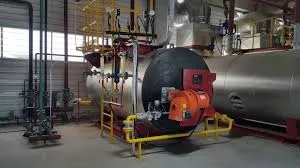
Oct . 15, 2024 12:43 Back to list
steam boiler types
Understanding Steam Boiler Types A Comprehensive Overview
Steam boilers are essential components in various industrial processes, providing the necessary heat and energy. They are widely used in power plants, manufacturing facilities, and even residential settings. Understanding the different types of steam boilers is crucial for selecting the right one for specific applications. In this article, we will explore the various steam boiler types, their working principles, and their applications.
1. Fire-tube Boilers
One of the most common types of steam boilers, fire-tube boilers, consists of a series of tubes that carry hot gases from a combustion source. The heat from these gases transfers to the water in the boiler, converting it into steam. Fire-tube boilers are favored for their relatively low cost and simplicity in design. They are widely used in small plants and residential applications.
Advantages - Simple construction and maintenance - Rapid steam generation - Suitable for lower pressure applications
Disadvantages - Limited capacity and pressure range - Less efficient than water-tube boilers
2. Water-tube Boilers
In contrast to fire-tube boilers, water-tube boilers circulate water through pipes that are heated externally by combustion gases. This design allows for a much higher pressure and temperature operation compared to fire-tube boilers. Water-tube boilers are often used in large industrial applications and power generation.
Advantages - High efficiency and capacity - Able to reach high pressure and temperature - Smaller footprint compared to fire-tube boilers
Disadvantages - More complex design and higher initial cost - Requires skilled personnel for operation and maintenance
steam boiler types

3. Electric Boilers
Electric boilers use electric heating elements to generate steam. They are becoming increasingly popular due to their efficiency and environmentally friendly nature. Electric boilers are ideal for applications where space is limited or where there is no access to traditional fuel sources.
Advantages - High efficiency with minimal emissions - Compact design and easy installation - Lower operating costs with stable energy prices
Disadvantages - Higher upfront costs compared to traditional boilers - Limited steam generation capacity for large-scale operations
4. Biomass Boilers
Biomass boilers utilize organic materials like wood, agricultural residues, or biofuels to produce steam. This renewable energy source helps reduce carbon emissions and is gaining traction in various industries. Biomass boilers can be comparable in efficiency to traditional fossil fuel systems.
Advantages - Renewable energy source - Reduces reliance on fossil fuels - Can often use waste materials as fuel
Disadvantages - Requires fuel storage and handling systems - Can have higher maintenance needs due to ash management
Conclusion
Choosing the right steam boiler type is crucial for any operation that relies on steam for heating or processing. Fire-tube, water-tube, electric, and biomass boilers each have unique benefits and limitations that make them suitable for different applications. Understanding these differences ensures that businesses can optimize their energy efficiency while meeting their operational needs. As industries continue to shift towards more sustainable practices, exploring advanced technologies in steam boiler design can pave the way for improved performance and environmental compliance.
-
High-Efficiency Commercial Oil Fired Steam Boiler for Industry
NewsJul.30,2025
-
High-Efficiency Biomass Fired Thermal Oil Boiler Solutions
NewsJul.30,2025
-
High Efficiency Gas Fired Thermal Oil Boiler for Industrial Heating
NewsJul.29,2025
-
High-Efficiency Gas Fired Hot Water Boiler for Sale – Reliable & Affordable
NewsJul.29,2025
-
High Efficiency Biomass Fired Hot Water Boiler for Industrial and Commercial Use
NewsJul.29,2025
-
High-Efficiency Biomass Fired Hot Water Boiler for Industrial Use
NewsJul.28,2025
Related PRODUCTS






















